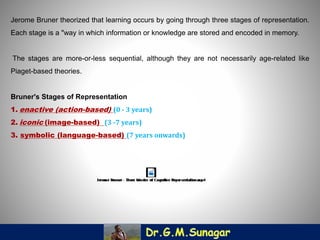BRUNER’S THEORY OF COGNITIVE DEVELOPMENT
- 1. BRUNER’S THEORY OF COGNITIVE DEVELOPMENT Dr. G.M.SUNAGAR Assistant Professor Vijayanagar College of Education Hubballi.
- 2. Born Jerome Seymour Bruner October 1, 1915 New York City, New York, United States Died June 5, 2016 (aged 100) Manhattan, New York, United States Residence New York City, United States Nationality American Fields Psychology Institutions Harvard University New York University University of Oxford Alma mater Duke University Harvard University Thesis A psychological analysis of international radio broadcasts of belligerent nations (1941)
- 3. Cognitive psychologist Jerome Bruner felt the goal of education should be intellectual development, as opposed to rote memorization of facts. Bruner held the following beliefs regarding learning and education: •He believed curriculum should foster the development of problem-solving skills through the processes of inquiry and discovery. •He believed that subject matter should be represented in terms of the child's way of viewing the world. •That curriculum should be designed so that the mastery of skills leads to the mastery of still more powerful ones. •He also advocated teaching by organizing concepts and learning by discovery. •Finally, he believed culture should shape notions through which people organize their views of themselves and others and the world in which they live.
- 4. Discovery Learning The concept of discovery learning implies that a learner constructs his or her own knowledge for themselves by discovering as opposed to being told about something. According to Bruner, the teacher should facilitate the learning process by developing lessons that provide the learner with information they need without organizing it for them. This idea of discovery learning is often referred to as constructivism, which emphasizes the active role of the learner in building understanding and making sense of information.
- 5. Jerome Bruner theorized that learning occurs by going through three stages of representation. Each stage is a "way in which information or knowledge are stored and encoded in memory. The stages are more-or-less sequential, although they are not necessarily age-related like Piaget-based theories. Bruner's Stages of Representation 1. enactive (action-based) (0 - 3 years) 2. iconic (image-based) (3 -7 years) 3. symbolic (language-based) (7 years onwards)
- 6. 1. enactive (action-based) (0 - 3 years) Sometimes called the concrete stage, this first stage involves a tangible hands-on method of learning. Bruner believed that "learning begins with an action - touching, feeling, and manipulating“ 2. iconic (image-based) (3 - 7 years) Sometimes called the pictoral stage, this second stage involves images or other visuals to represent the concrete situation enacted in the first stage. One way of doing this is to simply draw images of the objects on paper or to picture them in one's head. Other ways could be through the use of shapes, diagrams, and graphs. 3. symbolic (language-based) (7 years onwards) Sometimes called the abstract stage, the last stage takes the images from the second stage and represents them using words and symbols. The use of words and symbols "allows a student to organize information in the mind by relating concepts together“.
- 8. Educational Applications Teacher must understand the learners Give more hands on experience in the beginning Developing enquiry attitude among learners Developing mastery over the lauguage, because that is the important tool for learning Use more A-V aids in teaching and learning Student must learn by discovery approch Use graphs, models, pictures, specimans, charts, etc








